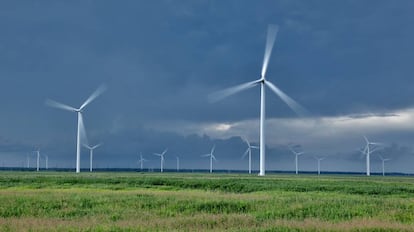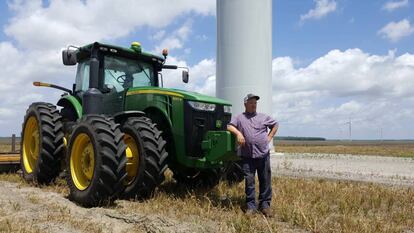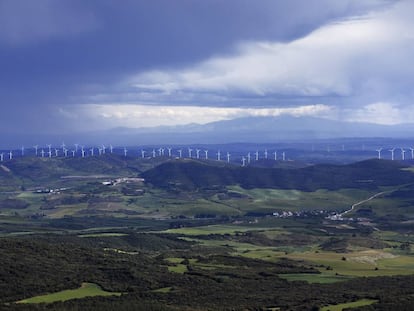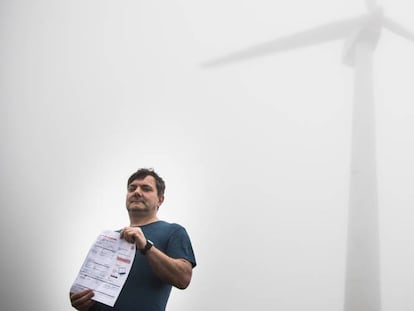How Spain’s Iberdrola is supplying Amazon with wind power in US
New energy farm in North Carolina helping to power e-commerce giant’s cloud-based data centers
Amazon.com began life as an online bookseller in 1994. Just eight years later, in 2002, the company, now the biggest retailer in the United States, set up Amazon Web Services (AWS) to provide on-demand cloud computing platforms, installing server farms in Northern Virginia, close to Washington. To power those server farms, Amazon commissioned Spanish energy giant Iberdrola to build wind-powered electricity generators in Elizabeth City, in Pasquotank County, North Carolina.

Northern Virginia – particularly in counties such as Loudon – has become a global connectivity hub: Google, Oracle and Microsoft also have strategic centers in the area and are expanding rapidly. Amazon, which earns some $10 billion a year from AWS, has 25 installations on the east coast, around half of the infrastructure of what the Washington Post has dubbed Data Center Alley.
Amazon’s cloud activity will soon have a capacity of more than one gigawatt, says Greenpeace, effectively doubling its clean electricity consumption since 2015. Avangrid Renewables, an affiliate of Iberdrola, will provide a fifth of AWS’s energy needs in the area.
Avangrid Renewables’ wind farm is made up of 104 latest-generation wind turbines
“Companies want clean energy, in the same way consumers want organic products” says Craig Poff, who oversees the Amazon Wind Farm US East project, dubbed Desert Wind. “It’s market forces that drive business,” he adds, citing Nike, Apple, and Walmart among other customers.
Global energy consultancy Wood Mackenzie has just published a report saying that wind and solar energy will redefine the energy market. “This is change that is underway,” it says, explaining that the fall in costs is seeing billions of dollars pumped into developing alternative technologies.
Specifically, wind energy generates 5% of total electricity in the United States, representing 40% of “new” energy entering the grid.
In the case of North Carolina, there were initial fears about its reliability. “Now those without it are complaining,” says farmer Horace Pritchard, on whose land some of the Iberdrola mills are being built, adding: “I prefer wind energy over solar because it doesn’t use as much land.”

Avangrid Renewables’ wind farm is made up of 104 latest-generation wind turbines. It began operations at the end of December and has been at full capacity since February. The turbines at Desert Wind are the tallest that Iberdrola operates, equivalent to a 50-story building, including the propeller, allowing for the blades to capture the strongest winds.
Desert Wind can generate 208 megawatts of electricity a year, enough to supply 61,000 homes. The original plan makes provision for boosting this to 300-megawatt capacity using around 100 more turbines. The owners of the land are paid $6,000 a year rent and the park generates around $500,000 a year for the local community in taxes.
Cristina Rehklau, head of tourism for Elizabeth City, says residents were initially unhappy at the idea of generating electricity to be used in another state. “But then they saw that the wind also generates economic benefits for the community,” she explains.
In the future, Amazon hopes to see all of its power needs met by renewable energy
Avangrid is the second-largest renewables energy company in the United States, with more than 600 projects underway and close to $10 billion in assets throughout 22 states. “Each project is a different world,” explains Mark Perryman, head of operations.
He says the Pentagon was unhappy about the initial planned height of the turbines at Desert Wind, fearing they would interfere with radars used to combat drug trafficking. “Any addition to the environment needs to be analyzed to establish its impact,” Perryman says. The other challenge the company faces comes from the hurricanes and tropical storms that regularly lash the coastline.
Amazon says that the wind farm in Elizabeth City is central to achieving its goal of using 100% renewable energy for its server farms. This year it says it will increase the figure to 50%. Perryman admits that for the moment, there will be times throughout the day when the farms will have to draw on electricity produced by less-clean sources of power such as natural gas.
English version by Nick Lyne.
Tu suscripción se está usando en otro dispositivo
¿Quieres añadir otro usuario a tu suscripción?
Si continúas leyendo en este dispositivo, no se podrá leer en el otro.
FlechaTu suscripción se está usando en otro dispositivo y solo puedes acceder a EL PAÍS desde un dispositivo a la vez.
Si quieres compartir tu cuenta, cambia tu suscripción a la modalidad Premium, así podrás añadir otro usuario. Cada uno accederá con su propia cuenta de email, lo que os permitirá personalizar vuestra experiencia en EL PAÍS.
¿Tienes una suscripción de empresa? Accede aquí para contratar más cuentas.
En el caso de no saber quién está usando tu cuenta, te recomendamos cambiar tu contraseña aquí.
Si decides continuar compartiendo tu cuenta, este mensaje se mostrará en tu dispositivo y en el de la otra persona que está usando tu cuenta de forma indefinida, afectando a tu experiencia de lectura. Puedes consultar aquí los términos y condiciones de la suscripción digital.
More information
Archived In
Últimas noticias
Maduro pleads not guilty before the federal court in New York: ‘I am still the president of Venezuela’
A new test can detect Alzheimer’s from a finger prick
UN team enters Sudanese city of El Fasher after paramilitary massacre: ‘It’s like a ghost town’
A recipe for resistance: Indigenous peoples politicize their struggles from the kitchen
Most viewed
- Gilles Lipovetsky: ‘If you want to live better and fall in love, take Prozac, don’t look to philosophy’
- Alain Aspect, Nobel laureate in physics: ‘Einstein was so smart that he would have had to recognize quantum entanglement’
- Maduro’s downfall puts China’s relationship with Venezuela to the test
- Why oil has been at the center of Venezuela-US conflicts for decades
- Alvin Hellerstein, a 92-year-old judge appointed by Bill Clinton, to preside over Maduro’s trial in New York










































